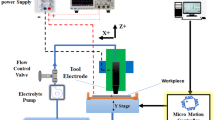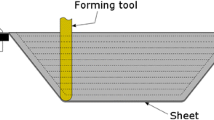Abstract
This paper proposes a new flexible and microscale roll gap control technology to obtain a stronger strip flatness control ability. According to the principle of microscale roll gap control technology, an electromagnetic control rolling mill with the function of roll profile control and large diameter ratio rolling is designed and built. To analyze the flatness control ability, a comprehensive finite element model (FEM) is established, and an indentation experiment and a rolling experiment are carried out. The simulation results show that under different rolling forces and tensions, the average quadratic crown control ability is more than 40 μm, and the average quartic crown control ability is more than − 3 μm. The control ability increment of the quadratic crown is greater than that of the quartic crown. In the indentation experiment, a stable roll profile can be achieved by PID control after reaching the target roll profile. Increasing the regulation amount can change the strip crown from positive to negative. Even under high rolling force conditions, microscale roll gap control technology can also realize a strip crown adjustment of 19.5 to 0.5 μm. Moreover, this technology can adjust the strip shape from edge waves to non-waves and middle waves in the rolling experiment. In this paper, the feasibility of using this technology to adjust the roll gap shape has been verified, and we demonstrate that the roll gap control goal of uniform transverse size distribution can be achieved.






















Similar content being viewed by others
Data availability
The data sets supporting the results of this article are included within the article and its additional files.
References
Cao JG, Xu XZ, Zhang J, Song MQ, Gong GL, Zeng W (2011) Preset model of bending force for 6-high reversing cold rolling mill based on genetic algorithm. J Cent South Univ 18:1487–1492. https://doi.org/10.1007/s11771-011-0864-6
Ogawa S, Hamauzu S, Matsumoto H, Kawanami T (2007) Prediction of flatness of fine gauge strip rolled by 12-high cluster mill. ISIJ Int 31(6):599–606. https://doi.org/10.2355/isi**ternational.31.599
Wang PF, Zhang DH, Li X, Liu JW, Wang JS (2012) Research and application of non-symmetrical roll bending control of cold rolling mill. Chin J Mech Eng-en 25(1):122–127. https://doi.org/10.3901/cjme.2012.01.122
Wang QL, Sun J, Liu YM, Wang PF, Zhang DH (2017) Analysis of symmetrical flatness actuator efficiencies for UCM cold rolling mill by 3D elastic–plastic FEM. Int J Adv Manuf Tech 92(10):1–19. https://doi.org/10.1007/s00170-017-0204-6
Wang QL, Sun J, Li X, Liu YM, Wang PF, Zhang DH (2018) Numerical and experimental analysis of strip cross-directional control and flatness prediction for UCM cold rolling mill. J Manuf Process 34:637–649. https://doi.org/10.1016/j.jmapro.2018.07.008
Aljabri A, Jiang ZY, Wei Z (2015) Analysis of thin strip profile by work roll crossing and shifting in asymmetrical cold rolling. Int J Mod Phys B 29:10–11. https://doi.org/10.1142/S0217979215400329
Lu C, Tieu AK, Jiang ZY (2002) A design of a third-order CVC roll profile. J Mater Process Tech 125:645–648. https://doi.org/10.1016/S0924-0136(02)00373-4
Li HB, Zhang J, Cao JG, Meng LL (2011) Analysis of crown control characteristics for SmartCrown work roll. Adv Mater Res 156–157:1261–1265. https://doi.org/10.4028/www.scientific.net/AMR.156-157.1261
Li HB (2012) Roll contour and strip profile control characteristics for Quintic CVC work roll. J Mech Eng 48(12):24–30. https://doi.org/10.3901/JME.2012.12.024
Linghu KZ, Jiang Z, Zhao J, Li F, Wei D, Xu J, Zhang X, Zhao X (2014) 3D FEM analysis of strip shape during multi-pass rolling in a 6-high CVC cold rolling mill. Int J Adv Manuf Tech 74(9–12):1733–1745. https://doi.org/10.1007/s00170-014-6069-z
Fei S, Li H, Kong N, Jie Z, Mitchell DRG (2017) Improvement in continuously variable crown work roll contour under CVC cyclical shifting mode. Int J Adv Manuf Tech 90(9–12):2723–2731. https://doi.org/10.1007/s00170-016-9587-z
Cao JG, Wei GC, Zhang J, Chen XL, Zhou YZ (2008) VCR and ASR technology for profile and flatness control in hot strip mills. J Cent South Univ T 15(002):264–270. https://doi.org/10.1007/s11771-008-0049-0
Wang XC, Yang Q, Sun YZ (2015) Rectangular Section Control Technology for Silicon Steel Rolling. J Iron Steel Res Int 22(3):185–191. https://doi.org/10.1016/S1006-706X(15)60028-0
Li YL, Cao JG, Qiu L, Yang GH, He A, Zhou YZ (2018) Research on ASR work roll contour suitable for all width electrical steel strip during hot rolling process. Int J Adv Manuf Tech 97:1–6. https://doi.org/10.1007/s00170-018-2198-0
Cao JG, Chai XT, Li YL, Kong N, Jia SH, Zeng W (2017) Integrated design of roll contours for strip edge drop and crown control in tandem cold rolling mills. J Mater Process Tech 252:432–439. https://doi.org/10.1016/j.jmatprotec.2017.09.038
SUMITOMO METAL IND (1994) Shape controller in sheet rolling. JP patent 6015319A:01–25
Arif, A.f.M., Ovaisullah Khan., Sheikh, A.K. (2004) Roll deformation and stress distribution under thermo-mechanical loading in cold rolling. J Mater Process Tech 147(2):255–267. https://doi.org/10.1016/j.jmatprotec.2004.01.005
Masui T, Yamada J, Nagai T, Nishino T (1983) Strip shape and profile control with a new type of the variable crown roll system. Trans Iron Steel Inst Jp 23(10):846–853. https://doi.org/10.2355/isi**ternational1966.23.846
Masui T, Matsumoto Y, Tomizawa A, Hirooka E (1992) Variable-crown roll: EP0338172
Zhang Q, Wang W, Zhou X (2008) Flatness control behavior of a DSR mill for wide steel strips. J Univ Sci Technol Bei**g 01, 71–76. https://doi.org/10.13374/j.issn1001-053x.2008.01.006
Du FS, Feng YF, Liu WW, Sun JN, Wang HJ (2017) Measuring technique for roll profile electromagnetic control in precision plate rolling. Iron Steel (11), 80. https://doi.org/10.13228/j.boyuan.issn0449-749x.20170139
Liu WW, Feng YF, Yang TS, Du FS, Sun JN (2018) Analysis of the induction heating efficiency and thermal energy conversion ability under different electromagnetic stick structures in the RPECT. Appl Therm Eng 145:277–286. https://doi.org/10.1016/j.applthermaleng.2018.09.043
Feng YF, Liu WW, Yang TS, Du FS, Sun JN (2019) A flexible electromagnetic control technique for interference adjustment in large-size sleeved backup rolls. Metall Res Technol 116(4). https://doi.org/10.1051/metal/2018122
Stolbchenko M, Grydin O, Samsonenko A, Khvist V, Schaper M (2014) Numerical analysis of the twin-roll casting of thin aluminium-steel clad strips. Forsch Ingenieurwes 3(78):121–130. https://doi.org/10.1007/s10010-014-0182-x
Yang TS, Liu JY, Zhou HN, Xu ZQ, Du FS (2021) Analysis of the thermal-force roll profile control ability under different hole structures and slot structures in the RPECT. Int J Adv Manuf Tech 116:403–415. https://doi.org/10.1007/S00170-021-07399-3
Funding
This project is supported by the National Natural Science Foundation of China (Grant No. U1560206) and National Natural Science Foundation of China (Grant No. 51374184).
Author information
Authors and Affiliations
Contributions
Tingsong Yang: conceptualization, methodology, writing—reviewing and editing, formal analysis. Qifa Chen: formal analysis, investigation, writing. Yanfeng Feng: formal analysis, investigation. Yang Hai: conceptualization, methodology. Fengshan Du: funding acquisition.
Corresponding author
Ethics declarations
Ethical approval
Not applicable.
Consent to participate
The authors consent to participate.
Consent to publish
The authors consent to publish.
Competing interests
The authors declare no competing interests.
Additional information
Publisher's Note
Springer Nature remains neutral with regard to jurisdictional claims in published maps and institutional affiliations.
Rights and permissions
About this article
Cite this article
Yang, T., Chen, Q., Feng, Y. et al. Experimental validation and numerical simulation of flexible and microscale roll gap control technology. Int J Adv Manuf Technol 120, 5741–5754 (2022). https://doi.org/10.1007/s00170-022-09000-x
Received:
Accepted:
Published:
Issue Date:
DOI: https://doi.org/10.1007/s00170-022-09000-x




